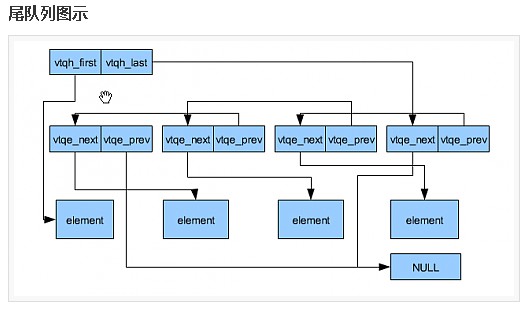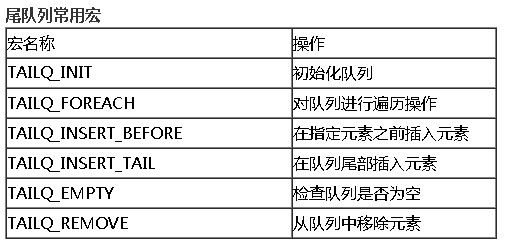c說話尾隊列tailq應用示例分享。本站提示廣大學習愛好者:(c說話尾隊列tailq應用示例分享)文章只能為提供參考,不一定能成為您想要的結果。以下是c說話尾隊列tailq應用示例分享正文
queue和list的構造界說和操作都在'sys/queue.h'中完成, 重要界說了上面四種數據構造:
1單向列表(single-linked lists)
2單向尾隊列(single-linked tail queue)
3列表(lists)
4尾隊列(tail queues)

應用示例
#include <stdio.h>
#include <stdlib.h>
#include <sys/queue.h>
/*
界說一個構造體,它只是尾隊列的一個元素
它必需包括一個TAILQ_ENTRY來指向上一個和下一個元素
*/
struct tailq_entry {
int value;
TAILQ_ENTRY(tailq_entry) entries;
};
//界說隊列的頭部
TAILQ_HEAD(, tailq_entry) my_tailq_head;
int main(int argc, char *argv[])
{
//界說一個構造體指針
struct tailq_entry *item;
//界說別的一個指針
struct tailq_entry *tmp_item;
//初始化隊列
TAILQ_INIT(&my_tailq_head);
int i;
//在隊列裡添加10個元素
for(i=0; i<10; i++) {
//請求內存空間
item = malloc(sizeof(*item));
if (item == NULL) {
perror("malloc failed");
exit(-1);
}
//設置值
item->value = i;
/*
將元素加到隊列尾部
參數1:指向隊列頭的指針
參數2:要添加的元素
參數3:構造體的變量名
*/
TAILQ_INSERT_TAIL(&my_tailq_head, item, entries);
}
//遍歷隊列
printf("Forward traversal: ");
TAILQ_FOREACH(item, &my_tailq_head, entries) {
printf("%d ",item->value);
}
printf("\n");
//添加一個新的元素
printf("Adding new item after 5: ");
TAILQ_FOREACH(item, &my_tailq_head, entries) {
if (item->value == 5) {
struct tailq_entry *new_item = malloc(sizeof(*new_item));
if (new_item == NULL) {
perror("malloc failed");
exit(EXIT_FAILURE);
}
new_item->value = 10;
//拔出一個元素
TAILQ_INSERT_AFTER(&my_tailq_head, item, new_item, entries);
break;
}
}
TAILQ_FOREACH(item, &my_tailq_head, entries) {
printf("%d ", item->value);
}
printf("\n");
//刪除一個元素
printf("Deleting item with value 3: ");
for(item = TAILQ_FIRST(&my_tailq_head); item != NULL; item = tmp_item) {
if (item->value == 3) {
//刪除一個元素
TAILQ_REMOVE(&my_tailq_head, item, entries);
//釋放不須要的內存單位
free(item);
break;
}
tmp_item = TAILQ_NEXT(item, entries);
}
TAILQ_FOREACH(item, &my_tailq_head, entries) {
printf("%d ", item->value);
}
printf("\n");
//清空隊列
while (item = TAILQ_FIRST(&my_tailq_head)) {
TAILQ_REMOVE(&my_tailq_head, item, entries);
free(item);
}
//檢查能否為空
if (!TAILQ_EMPTY(&my_tailq_head)) {
printf("tail queue is NOT empty!\n");
}
return 0;
}